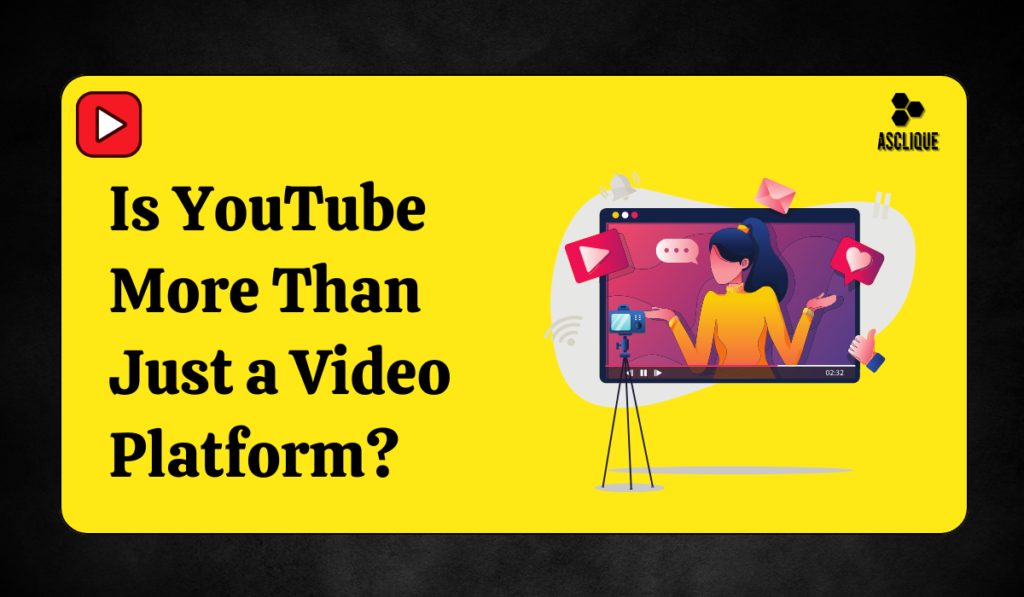Social Media: What Is It?

It would be beneficial to clarify what social media is in order to address the question, “Is YouTube social media?” The Merriam-Webster dictionary describes social media as online platforms or applications that enable users to interact socially and share or create content. These platforms generally have some of the following traits in common:
- Content created by users: User-generated material is essential to social media’s success.
- Engagement and interaction: Users can post comments, likes, or shares to engage with other users.
- Building of communities: The platform allows users to make contacts and build communities with shared interests.
- Content discovery: Social media enables users to discover new content depending on algorithms or user preferences.
Social media sites are varied, and they fall into several categories based on their core purpose and the way in which users utilize the product:
- Networking sites: Examples include Facebook, LinkedIn, and Twitter. They are mostly used to connect with others, get updates, and engage with other people. Networking surrounds the creation of personal or professional networks.
- Visual Platforms: This category includes Instagram and Pinterest. These are websites that primarily allow the sharing of images and graphics or other kinds of visual media. They are led by aesthetics and storytelling in the forms of images as well as short videos.
- Microblogging Platforms: The representation of this category are those platforms like Twitter and Tumblr, where users are meant to share smaller quick thoughts or updates. One primary definition of Twitter is as a rapid short form of communication for news, trends, and discussions.
- Video-Sharing Platforms: This category involves YouTube, Vimeo, and TikTok, which actually focus mainly on video content. These sites have made it possible for people to upload their contents, share them with the larger world, and interact with other users through video content. Users can comment, like, and share videos, making the sites very interactive.
So where does YouTube fit? Though YouTube’s origins are as a video-sharing platform, it has evolved, at least to a certain extent, into a social media platform to include comments, community posts, likes, and subscribing. Thus, a user can establish a community based on a channel and communicate with the person who is the creator, even participate in live chats for streams, sending YouTube squarely into the world of social media.
When YouTube first came out in 2005, it was a video uploading site. After years of development, however, the site has evolved drastically, with most elements more characteristic of social media sites. Now, for instance, comments, likes, and community features characterize YouTube, which makes the site far more interactive and engaging. This is because users can follow their favorite channels, join discussions, and even contact content creators directly.
But then, what about YouTube? Do these features mark it as social media? And the answer would seem to be ever more yes.
YouTube’s Key Social Features
Some of YouTube’s main social media-like features include:
- Comment Sections: Comment sections are one of the most prominent social features of YouTube; through these sections, viewers can express opinions, answer questions, or discuss video content with their favorite creators as well as other fellow viewers.
- Likes and Dislikes: Similar to Facebook or Instagram, users can interact with the videos by providing a like or dislike to the content. The feature allows users a direct method of feedback.
- Community Tab: Recently, YouTube also added a “Community” tab to the millions of following creators. Using posts, polls, and images—all popular user engagement features on Facebook and Twitter—they can interact with their followers through this feature.
- YouTube Stories: The “Stories” feature on YouTube allows content creators to post brief, brief videos for viewers to watch and share. This feature is similar to Instagram and Snapchat.
- YouTube Live: Content producers can broadcast videos in real-time and interact with viewers through live chats thanks to this feature. Again, this is another aspect of what makes YouTube a social platform.
Subscription and Notification Feature: Subscribe to any channel is like following someone’s feed on Twitter or Instagram. YouTube permits one not to miss work from the favorite creators.
Is YouTube Social Media or a Video Platform?
Easily enough, yes, it can be conceived of as purely a video platform. However, such a perception completely misses how deeply social the platform has become, and with that, end-gain-ful potential to share, comment, and even build communities, which do in fact strongly fit with the definition of social media.
Moreover, YouTube runs on user-generated content, yet another feature of social media. Users upload their content, create communities around the channels, and connect one-on-one with the audience. There are beauty influencers, gamblers, etc. that take advantage of the platform’s ‘social’ nature to establish their brand and increase followers.
- 2.5 billion monthly active users: YouTube is the second largest search engine worldwide and the most popular social media site in the world regarding user base, after Facebook.
- Billion hours watch every day: People spend over a billion hours watching content on YouTube daily.
- 62% of businesses: A study has unveiled that 62% of businesses prefer using YouTube as an option for promoting their products to its vast audience.
- 71% of users: This also means most YouTube users find new content through the recommendation system-an algorithmic base inspired by the algorithms familiar on other social media channels.
These statistics point to the reach and influence that put on the platform, the way making it more than a video-sharing platform and a social media giant that powers creators and users through interaction, sharing, and discovery.
The Rise of YouTube Creators: A Social Media Phenomenon
With YouTube creators, or “YouTubers,” at the heart of the building of communities and relationships with devoted followers, those top creators such as MrBeast, PewDiePie, and Lilly Singh have millions of subscribers that they interact with repeatedly through comments, social media, and even merchandise. As influencers on Instagram or TikTok may be, YouTubers continue to engender engagement, which has already solidified YouTube’s place as an enormous player in social media.
Taking mastery over the social media of YouTube for your business requires a strategy focused on content creation and audience engagement. This is how you can use YouTube as a social media platform for your business:
- Create Engaging, High-Quality Content: First and foremost, produce videos that talk to the interest of your audience: having informative, entertainment, or helpful content. The next thing is that they will like to watch you continuously as long as your content is of good quality and puts together clear messaging.
- Consistency is the Key: If you really want to grow a business on YouTube, you must be consistent in uploads. This will help in building trust with your audience and bringing them back for more in the future. Set up a posting schedule that viewers can rely on.
- Connect with your audience. YouTube is a social medium, and so interaction is vital. Interact with comments posted; ask for people’s opinions with questions; and use the “Community” tab to post updates or polls. Lastly, live streams can be done to connect with your audience in real time.
- Optimize Your Videos for Search: To maximize viewership, make sure the videos you upload are search-engine-friendly. Use titles, descriptions, and keywords you place in your video’s tags that feature keywords to your topic or niche. This makes your video content rank better in YouTube searches, which then makes it easier for potential clients to find the video.
So, by posting high-quality regular uploads and connecting more meaningfully with viewers, businesses can tap into the vast audience of YouTube and turn it into a potent tool for growth.
Conclusion: Is YouTube Social Media?
So, is YouTube social media? Absolutely. While YouTube began as a basic video-sharing site, it has evolved into a full-fledged social media company where users can interact, share content, and build communities. The platform provides everything from comment sections and live streaming to subscription services and interactive community features.
YouTube has an enormous user base, the emerging new influencers, and integration of new social elements that is quite evident to everyone: YouTube is no longer a video site but a partner in social media.
FAQs
Is YouTube social media or a video platform?
YouTube is both; it’s a video platform with social media features.
Why is YouTube considered a social media platform?
YouTube allows user interaction through comments, likes, and subscriptions.
Can YouTube become a social networking site?
YouTube already acts as a social networking site by enabling user connections and engagement.
What are the social features of YouTube?
Social features include comments, likes, subscriptions, community posts, and live streaming.


